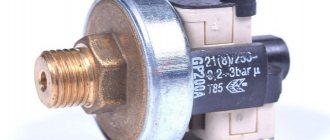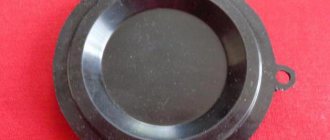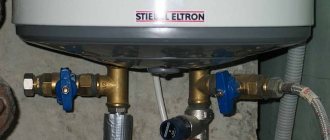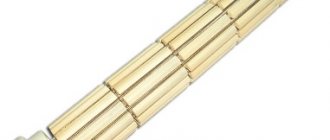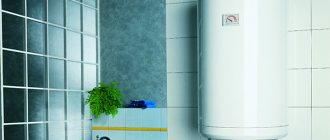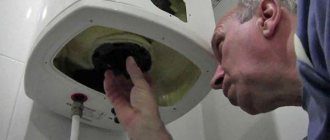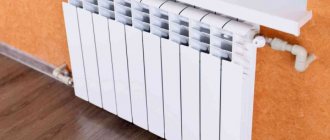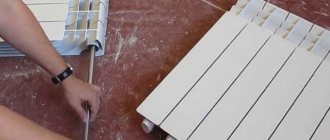Signs of a clogged water heater
During normal operation of the unit, there is no need to resort to preventive maintenance once again. The boiler should be cleaned if at least one of the following signs is present:
- long-term heating of water;
- change in temperature;
- increase in electricity consumption (can be determined by the meter readings when the water heater is turned on);
- tank overheating;
- presence of extraneous noise during boiler operation;
- changes in water color.
Depending on the quality of the water, the degree of contamination may be different Source nagrevalki.com
When supplying low-quality water through the water supply system, the water heater should be cleaned once a year. This should also be done if there is hard water or the boiler is turned on and off frequently.
If the water heater has been working properly for a long time and there are no signs of urgent cleaning, then preventive maintenance is carried out. As a rule, it is carried out in these conditions no more than once every three years.
Cleaning the boiler and heating element without disassembling
The boiler requires regular cleaning, since low-quality water impairs the functionality of the device. Scale has low thermal conductivity, which is why equipment consumes more electricity without producing the desired effect. Over time, such heating elements simply burn out.
Signs that your device needs cleaning
Anti-scale filter for boilers and boilers
It is worth paying attention to certain signs that indicate that it is necessary to clean the heating element of the water heater:
- the water began to heat up for a long time;
- increased energy consumption;
- the boiler makes noise when heating;
- the water turned yellowish;
- the water has an unpleasant smell of hydrogen sulfide;
- the walls of the heater, surrounding equipment, sockets and walls overheat;
- a hissing sound is heard during heating;
- The boiler started turning on and off.
There are other ways to determine that the tank needs to be descaled. First of all, you should look at the hardness of the water. If it is elevated, it is recommended to clean the water heating element and tank at least once every six months. If the level is normal, then flushing can be done once every 2 years.
Additional Information! You can determine the hardness of water by a white coating. If it regularly appears on taps and mixers, and washing products and shower gels do not foam well, then this is an indicator of a high lime content in running water. You can also check its concentration using special devices.
It is also recommended to install a filter so that purified water is supplied to the water heater. There are special anti-scale filters for boilers and geysers. They are able to purify and soften water, which keeps the device system in good condition. The filter can even remove some salts and metal compounds.
Cleaning methods
Disconnecting the cold water supply hose
You can clean the heating element and boiler in two ways: by physical force and using acid solutions. The mechanical method involves disassembling the water heater, which is impossible to carry out under some conditions, for example, if it is large.
In order not to remove the boiler from the wall, you can arm yourself with folk cleaning products: vinegar and citric acid. However, they will only soften the scale, which will fall to the bottom of the boiler at the end of the cleaning process. Over time, it will accumulate, so mechanical cleaning will not be avoided.
Since you can descale the boiler without disassembling it, you should know the exact cleaning instructions:
- Turn off the tap responsible for supplying cold water to the boiler.
- Disconnect the water pipe from the connection on the water heater.
- Open the hot water tap and drain most of the water, leaving a third of it.
- Close the hot water tap and screw the hose onto the heater nozzle.
- Insert a watering can onto the second edge of the hose and secure it above the top level of the tank.
- Pour in the cleaning solution and leave overnight (6 hours is enough).
- Drain the dirty liquid by opening the hot water tap.
- Rinse the tank with cold tap water.
Important! Don't rush dirty water to the faucet. It is necessary to install an additional drain valve on the water heater pipe.
You can descale a boiler using folk remedies or special purchased substances - the operating principle is the same. Such cleaning is required to be carried out regularly, but it is often impossible to remove dirty water with scale that has fallen off the heating element from the tank, so mechanical cleaning cannot be canceled.
Preparing for work
The first step is to disconnect the water heater from the power supply. Then you should turn off the water supply by opening the valves on the connected pipes. Before starting cleaning, be sure to drain the water from the tank.
A hose must be connected to the drain valve through which the drain will occur. Source santehnapevi.ru
These are instructions for this stage of work, which are designed for a specific installation option for the water heater.
Diagram of the correct connection of the boiler to the water supply system Source wp.com
The installation of water heaters can be different, which makes some adjustments to the process of draining water. For example, in the absence of drain taps, drainage can occur through a safety valve. The pipe through which hot water is supplied from the boiler must be unscrewed and installed in a bucket. After this, the valve is removed and the water is drained.
See also: Catalog of companies that specialize in engineering systems (heating, water supply, sewerage and others) and related work
Tips for proper use
Modern electric boilers are reliable, efficient and environmentally friendly equipment for individual heating of hot water.
These heaters are widely installed not only in one-story private houses, in the absence of a centralized hot water supply, but also in multi-story buildings as an alternative heating method.
Tips for extending the life of an electric boiler:
- Install filters for water purification at the consumer's subscriber input.
- It is not recommended to purchase and install devices with galvanized electric heating elements or made of ferrous metals.
- Install magnetic thermostats.
- Periodically heat the water at maximum temperature for disinfection.
- Periodically check the operation of the safety valve to prevent rupture of the housing due to high pressure.
- Install a voltage stabilizer in case of poor performance of the electrical network.
- Avoid humidity in the room to preserve the electronics and device chips.
- Protect an idle boiler from freezing by disconnecting it from the water supply and carefully draining the water from the housing.
Despite the fact that the boiler is a fairly reliable device with a long service life, however, if installed, operated and maintained incorrectly, it quickly fails and it depends only on the user how long it will serve him.
Unwinding the boiler
This is the second stage of preparatory work immediately before cleansing. There is also a clear sequence of actions here:
- Unscrew the fixing bolts that secure the water heater cover.
- Remove the cover itself, but carefully pull the latches out of the grooves.
- Remove the thermostat (just pull it down).
- Unscrew the bolts holding the protective panel.
The wiring diagram must be remembered or sketched Source boilervdom.ru
- Disconnect the power cables and grounding cable.
- Remove the seal.
- Remove the heating element.
- Disconnect the flange.
After going through all the points of this instruction, you can begin the main work of cleaning the water heater.
Instructions for starting the boiler for the first time
Boiler installed
Whether the installation work was carried out by specialists or the owner does not matter. In any case, you need to check the operation of the system. To do this, following the given tips, you need to start the heater for the first time.
To do this, following the given tips, you need to start the heater for the first time.
We start by checking the correct connection of the systems that are responsible for heating the water. Fidelity, reliability of connection of phase and neutral wires, presence of grounding. The functionality of the circuit breaker should also be checked. To do this, use a device - a tester or a special electrician's screwdriver. Next comes the search for leaks in the system. It would be useful to control the connection of underwater pipes. Presence and diagnostics of check valve operation. Running water into the boiler
Attention, the correct sequence of actions for the first and subsequent starts of the system will be described in the next section. Repeated search for water leaks in pipe installation areas
Diagnostics of heater operation. Turn on the device by pressing the power button. Fixing the initial temperature sensor readings. Recheck after 15 minutes
An increase in indicators indicates the correct connection of the heating elements.
Study the recommendations on how to connect the boiler to the water supply, follow safety rules.
Read how to make an indirect heating boiler with your own hands.
How to drain water from a boiler: tips, recommendations, step-by-step instructions in our article.
Cleaning methods
The main problem with water heaters is scale. Everyone will choose for themselves how to clean the boiler. It is worth noting that the methods may be different. First of all, the difference lies in what exactly will be cleaned: the tank itself or the heating element.
Cleaning the heating element
When the heating element is removed from the boiler body, you will notice that it is covered with a layer of dirt. It is easy to remove dirt manually using a rag or brush. However, underneath the top layer there will inevitably be scale, which is much more difficult to remove.
If the contamination is severe, you can use a metal brush or knife, but be careful not to damage the metal tube of the heating element Source ruvoda.com
To clean scale, you can purchase a specialized anti-scale product. Almost all solutions presented in stores are suitable for cleaning heating elements.
However, you can resort to a tried and tested folk remedy. To do this you need to take:
- vinegar solution 9% - 100 ml;
- baking soda – 50 gr.
The indicated amount is calculated for 1 liter of water. A solution is made in warm water and the heating element is immersed in it. It should be kept in this way for 24 hours.
Another common method of cleaning with folk remedies is soaking in a solution of citric acid. It is enough to dissolve 50 g of powder in 1 liter of water.
Two cleaning methods are combined here: mechanical (knife, brush, etc.) and chemical (using solutions).
Causes of scale
In order to clean the water heater less frequently, owners install filters on the incoming water pipe. They trap coarse particles and dirt, but the water hardness remains the same. Modern cleaning systems are not affordable for everyone and they also do not guarantee 100% results. Due to increased water hardness, lime deposits – scale – accumulate in the water heater. A hard crust first covers the heating element, and then the inner surface of the storage tank.
Assembling the water heater after cleaning
The boiler must be reassembled in the reverse order of the disassembly instructions. When installing the heating element, you need to pay attention to the rubber seal. It must be intact and not damaged. In any case, additional treatment of the seal with silicone sealant will be required.
After installing the heating element and sealing the boiler, it is necessary to install it in its original place. When connecting the boiler, turn on the hot water supply tap and open the tap through which cold water is poured.
This way the water heater is checked for leaks Source 1c-bitrix-cdn.ru
After checking the boiler, the thermostat and electrical wires are connected. This must be done in strict accordance with the diagram sketched or photographed when disassembling the boiler.
How to disassemble a Termex water heater
Thermex is a leading company in Europe that manufactures only water heaters. Water heaters from this company rarely break down, but it happens, and for repairs and preventive maintenance you need to know how to disassemble such water heaters.
Before disassembling the boiler, you must first turn off the water supply and disconnect the heater from the mains
Disassembling a water heater from this company should be done as follows:
- Shut off the water supply to the boiler. If the water heater is installed correctly, a tap must be installed at the bottom of its body to shut off the water supply.
- Disconnect the heater from the power supply.
- Using a straight screwdriver, carefully remove the protective cover. If the lid is seated very tightly, then it is necessary to pry the edges of the lid in a circle. When removing the cover, it is important not to damage the enamel.
- After dismantling the cover, you need to check all contacts with an indicator or special equipment. The device or indicator should not show that there is voltage.
- Drain all the water from the barrel. Note that in some situations it becomes necessary to remove the boiler from the wall.
- Before disconnecting the wires from their contacts, you must record the location of the wires on your phone. This is necessary for ease of connection.
- We unscrew the nuts that hold the heating element and thermostat one at a time. This unscrewing is necessary so that the remaining water drains gradually. After you have taken out the heating element and thermostat, you need to wipe them with a dry cloth. And check the gaskets for wear.
Sectional design of a boiler or water heater
A storage-type water heater, or boiler in common parlance, has the appearance of a closed reservoir and is shaped like a cylinder. Under the decorative shell there is a storage tank into which water is collected for heating. Between the tank and the coating there is a heat insulator that limits heat loss when heating water.
If you decide to disassemble and repair the boiler yourself, then experts recommend that you first become familiar with the design and operating principle of the water heater in detail.
The water supply to the tank comes from the supply hose at the bottom of the tank. There is a heating element inside this tank; it works on the principle of a boiler. The heating element heats itself up and then begins to heat the water around it. When the hot water supply is opened, heated water is taken from above, since warm or hot water is lighter than cold water and therefore it rises to the top of the boiler tank. Often the hot water outlet is located at the bottom, meaning the hot water supply pipe takes water from the top of the tank and carries the water down along the tank to the water outlet.
A thermometer is built into the bottom of the water heater, which automatically turns on the water heating and shows how warm the device is if the water is below the set temperature and, on the contrary, turns it off after bringing the water temperature to the required one. That is, the technique is a kind of thermopot.
Very often in the design of a water heater you can find an air vent; it is located in the upper part of the storage tank. It is designed to relieve pressure that is formed during the heating process of water in a closed volume. The air vent operates in manual mode, that is, not automatically on its own, but only in the presence of a person and with the help of his hands.
An additional element in the boiler design is the presence of a safety valve. It acts as an automatic release of excess pressure. It is located at the cold water inlet. It allows water to seep and dribble when there is a sudden increase in pressure in the water supply. To prevent it from dripping onto the floor, simply put a hose on it and place a container nearby for drainage or lower it into the sink, bathtub or toilet.
